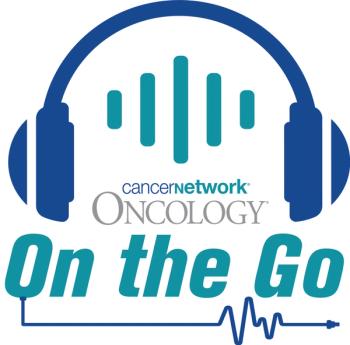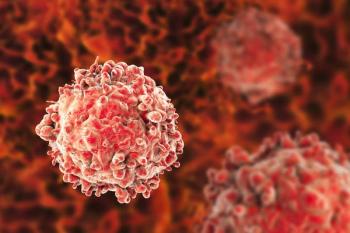
Treatment with Adjuvant Atezolizumab Yields DFS Benefit Across Numerous Subgroups in Early-Stage NSCLC
Patients with early-stage non–small cell lung cancer experienced a survival benefit with adjuvant atezolizumab vs best supportive care.
The use of adjuvant atezolizumab (Tecentriq) resulted in an improvement in disease-free survival (DFS) for patients with PD-L1–positive, stage II to IIIA non–small cell lung cancer (NSCLC), according to findings from an exploratory analysis of the phase 3 IMpower010 trial (NCT02486718) that were presented at the International Association for the Study of Lung Cancer’s 2021 World Conference on Lung Cancer.1
Results showed that in the population of patients with stage II to IIIA NSCLC who had at least 1% PD-L1 expression on tumor cells (n = 476), DFS favored the atezolizumab arm over the BSC arm in all subgroups, except for those who previously received a chemotherapy regimen of cisplatin and gemcitabine (n = 75; HR, 1.14; 95% CI, 0.50-2.61).
In the all-randomized stage II to IIIA patient population (n = 882), DFS favored adjuvant atezolizumab over BSC in all subgroups except for those who had undergone bilobectomy (n = 47; HR, 1.02; 95% CI, 0.35-2.98).
In the intent-to-treat (ITT) population (n = 1005), which included those with stage IB to IIIA disease, DFS generally favored atezolizumab vs BSC in all subgroups except for those with stage IB disease (n = 123; HR, 1.01; 95% CI, 0.48-2.13) who had undergone bilobectomy (n = 50; HR, 1.14; 95% CI, 0.39-3.34) and those who had received cisplatin/gemcitabine (n = 165; HR, 1.03; 95% CI, 0.62-1.70).
“We did an exploratory analysis to try and understand the impact of prior therapies [on DFS outcomes] and…in the target population of PD-L1–positive, stage II to IIIA [disease], we noticed a significant advantage in DFS that favors the atezolizumab arm,” Nasser Altorki, MD, of New York-Presbyterian Hospital, Weill Cornell Medicine, said during a press briefing on the data. “In all randomized [patients] with stage II to IIIA [disease], the atezolizumab arm again was favored in [terms of] DFS across mostly all categories. For the ITT [population], this still awaits final analysis of DFS, but there’s a general trend favoring the atezolizumab arm.”
IMpower010 enrolled patients with completely resected, stage IB to IIIA NSCLC with an ECOG performance status of 0 or 1, who had undergone lobectomy/pneumonectomy, and had tumor tissue available for PD-L1 analysis. If patients had stage IB tumors, they had to be 4 cm or greater.
A total of 1280 participants received 1 to 4 cycles of cisplatin plus pemetrexed, gemcitabine, docetaxel, or vinorelbine. A total of 275 patients did not undergo randomization after having received chemotherapy. The main reason for discontinuation was withdrawn consent (31.3%), followed by disease relapse (19.6%), other (14.9%), toxicity (12.4%), death (6.9%), physician decision (6.5%), protocol deviation (6.5%), loss to follow-up (1.5%), and symptomatic deterioration (<1.0%).
The remaining 1005 patients were randomized to receive atezolizumab at 1200 mg every 21 days for 16 cycles or BSC. No crossover was permitted. Stratification factors included gender (male vs female), disease stage (IB vs II vs IIIA), histology, and PD-L1 tumor expression status.
“There was a hierarchical statistical design in which we looked at the primary end point of DFS first in the target population of [patients with] PD-L1–positive stage II to IIIA [disease], and if that was positive, then we would look at the DFS in the [all-randomized] population. [If positive, we would look at DFS in the ITT population], which included [those with] stage IB [disease],” Altorki noted. “The secondary end point would be overall survival [OS] in the [ITT population].”
Patient, disease, and treatment characteristics in the ITT population was noted to be well balanced between the 2 treatment arms. The median age of participants was 62 years (range, 26-84), 66.9% were male, 55.3% had an ECOG performance status of 0, 65.6% had nonsquamous histology, and 54.6% had a PD-L1 tumor cell expression of 1% or higher.
Regarding disease stage, 12.2% of patients had stage IB disease, 29.4% had stage IIA disease, 17.3% had stage IIB disease, and 41.1% had stage IIIA disease. Notably, 80.7% of patients had mediastinal lymph node dissection and 18.0% had mediastinal lymph node sampling. Lymph node status was N0 in 35.0% of patients, N1 in 34.6%, and N2 in 30.3%.
Additionally, the majority of patients (78.1%) underwent lobectomy, 15.9% had a pneumonectomy, and 5.0% had a bilobectomy. The median time from surgery to first treatment with atezolizumab or BSC was 5.2 months (range, 2.3-8.0).
Of the 1005 patients, most (38.3%) received prior cisplatin/pemetrexed; 30.1% had received cisplatin/vinorelbine, 16.4% had cisplatin/gemcitabine, and 15.1% received cisplatin/docetaxel.
“Overall, there was very good compliance with the receipt of 4 cycles of chemotherapy,” Altorki noted. “This was slightly lower in patients who received cisplatin/gemcitabine.”
Primary results from IMpower010 were presented during the 2021 ASCO Annual Meeting and demonstrated that adjuvant atezolizumab significantly improved DFS over BSC in patients with PD-L1–positive stage II to IIIA NSCLC and in the all-randomized stage II to IIIA population, meeting the primary end point.2
In the PD-L1–positive subgroup, the median DFS had not yet been reached (95% CI, 36.1–not evaluable [NE]) with atezolizumab vs 35.3 months (95% CI, 29.0-NE) with BSC (stratified HR, 0.66; 95% CI, 0.50-0.88; P = .004). In the all-randomized population, the median DFS in the investigative and control arms was 42.3 months (95% CI, 36.0-NE) and 35.3 months (95% CI, 30.4-46.4), respectively (stratified HR, 0.79; 95% CI, 0.64-0.96; P = .02).
The statistical significance boundary for DFS was not crossed in the ITT population, although “it appears from the curve that there is a better DFS in the atezolizumab arm,” Altorki noted. In this subgroup, the median DFS had not yet been reached (95% CI, 36.1-NE) with atezolizumab vs 37.2 months (95% CI, 31.6-NE) with BSC (stratified HR, 0.81; 95% CI, 0.67-0.99; P = .04).
Planned analyses of DFS and OS in the ITT population will continue with longer follow-up.
References
- Altorki N, Felip E, Zhou C, et al. IMpower010: characterization of stage IB-IIIA NSCLC patients by type and extent of therapy prior to adjuvant atezolizumab. Presented at: International Association for the Study of Lung Cancer 2021 World Conference on Lung Cancer; September 8-14, 2021; virtual. Abstract PL02.05.
- Wakelee HA, Altorki NK, Zhou C, et al. IMpower010: primary results of a phase III global study of atezolizumab versus best supportive care after adjuvant chemotherapy in resected stage IB-IIIA non-small cell lung cancer (NSCLC). J Clin Oncol. 2021;39(suppl 15):8500. doi:10.1200/JCO.2021.39.15_suppl.8500
Newsletter
Stay up to date on recent advances in the multidisciplinary approach to cancer.
































































































